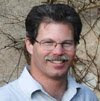Complex legs like these start with a paper pattern printed full-scale from the computer model. The patterns are placed on the plywood template material such that the mating edges of the parts line up with the straight-and-square milled plywood edges.
Once they're rough milled on the bandsaw, they're smoothed and faired by hand with rasps and sandpaper.
The parts are then laid out on the rough lumber to take best advantage of grain.
Once they're rough milled, again on the bandsaw, the mating edges are trimmed straight using a straight-edge saw guide.

After the mating faces are established, dadoes are cut across them to form bridle joints.

The next step is to trim them to exactly match the templates using the router table. In a design like this, with highly curved parts that meet at variable angles its important to leave flat ears to act as clamping aids.

The next step is to mill and attach the contrasting feet. To create a pleasing look, its important to maintain a continuous grain flow from leg to foot. With legs that are square in cross-section, structural integrity can be maintained by creating the foot by just veneering the bottom of the leg. But with curved legs that are rounded in cross-section its much easier to simply attach a solid foot to the leg that can be shaped and smoothed with impunity. Because the joint between feet and legs in this situation is, by necessity, an end-grain to end-grain joint, it has very little structural integrity. Therefore I always support this type of joint with a mechanical fastener, aka, a screw. Once the pre-drilled foot is glued in place, a pilot hole is drilled into the leg and the screw inserted.

Once the foot is attached, the leg can be tapered and rounded. Because the tapered legs change in thickness along their length, the radius of the edges has to change, as well. To make this easier, I use several round-over router bits of increasing radius as I move up the leg. This makes creating a consistently changing edge profile a snap.

Here are the four back leg pieces dry fit together. You can see the floating bridle tenon that connects all four pieces, as well as the positions of the clamping ears at critical points.
After the back leg sub-assembly has dried, the clamping ears are removed and the final fairing completed.
Et voilá, the assembled base.











Woodworking Projects and Plans are much sought after stuffs today both online and
ReplyDeleteoffline because woodworking has gone to a whole new level in today’s time.
People want exceptional and attractive design and also they are short of time
so they need it pretty quickly and they can’t afford to waste too much time
on searching for Woodworking Plans here and there buy woodworking projects